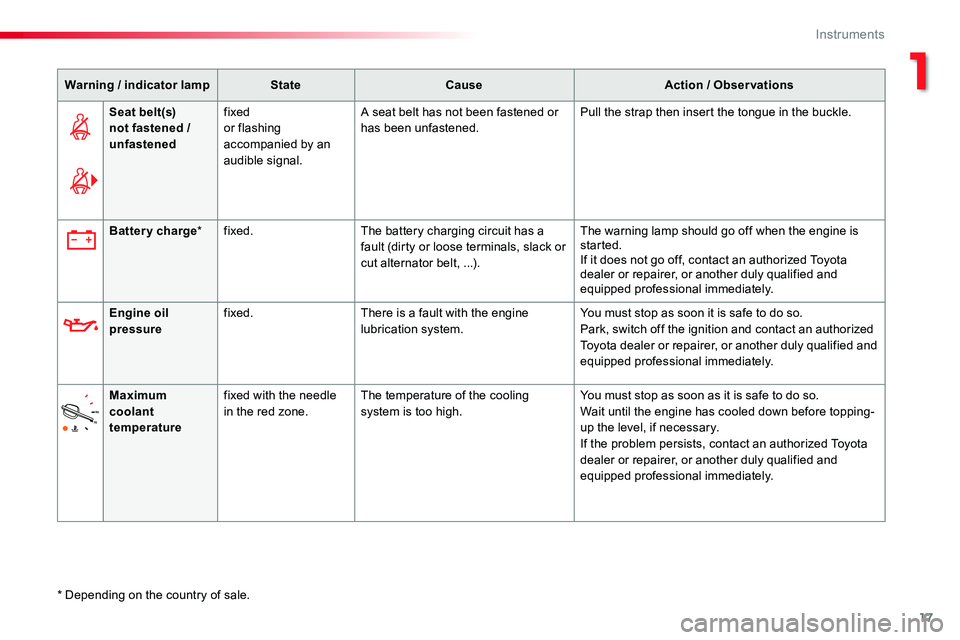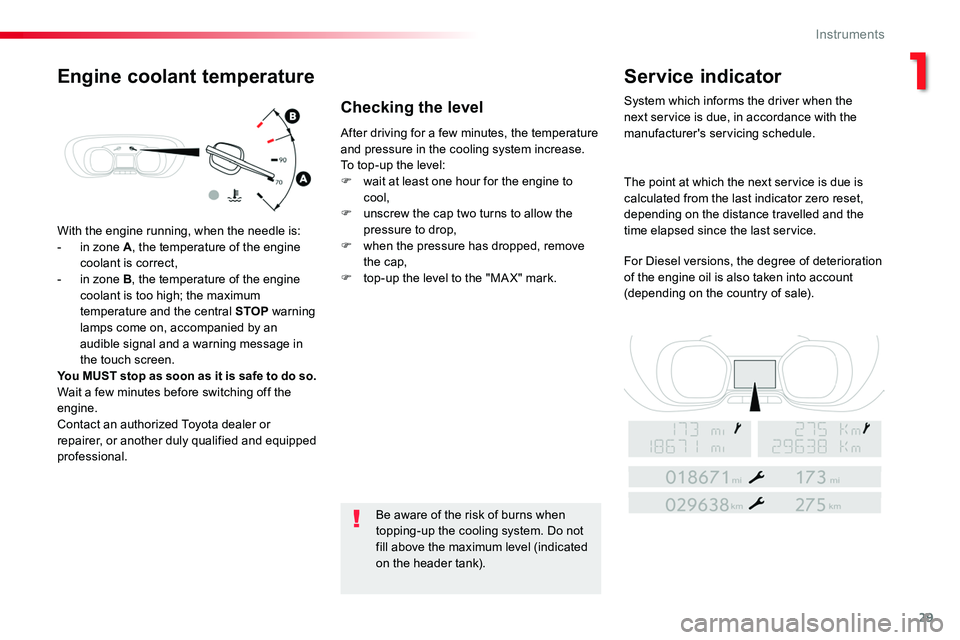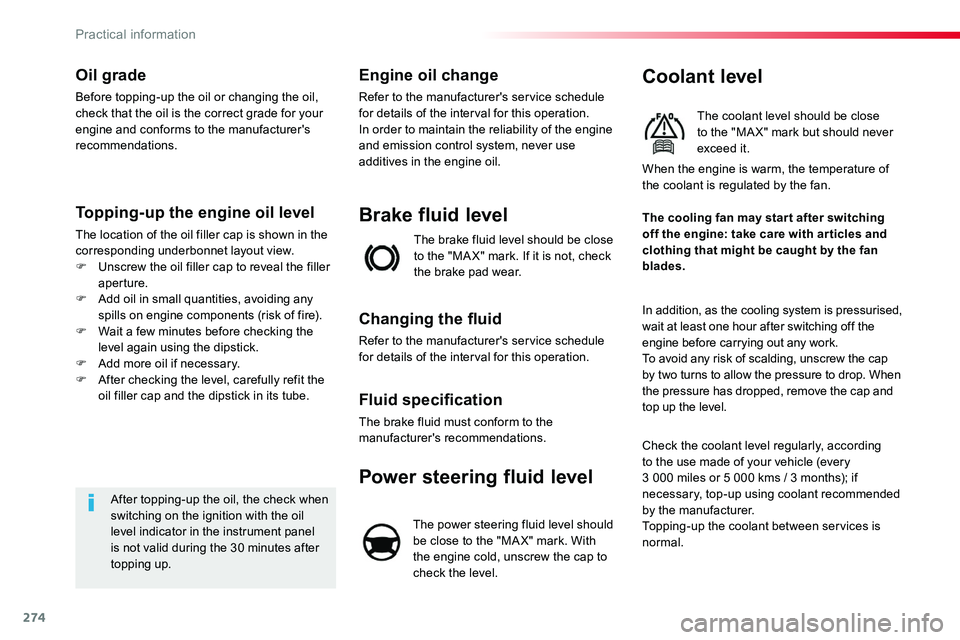Page 9 of 504
9
Maintenance - Technical data
Dimensions 323Identification markings 327
Running out of fuel, (primimg pump) 322
Checking levels 273 -275- oil- brake fluid- power steering fluid- coolant- screenwash, headlamp wash fluid
- additive (Diesel with particle filter)
Changing bulbs 298-310- front- rear
12V battery 316 -320
Opening the bonnet 271Under the bonnet 272Engines 324-326AdBlue® 278 -281
Weights 324-326
Load reduction, economy mode 266
Engine compartment fuses 311- 312, 315
.
Over view
Page 13 of 504
13
1. Analogue speedometer (mph or km/h).
2. Fuel gauge.3. Engine coolant temperature gauge.4. Cruise control or speed limiter settings.5. Digital speedometer (mph or km/h).
A. Reset the service indicator.
Temporarily recall information on:- servicing,- remaining driving range with the emissions fluid (AdBlue®).B. Main lighting dimmer.C. Reset the trip recorder.
6. Gear shift indicator.
Gear with an automatic or electronic gearbox.7. Service indicator, then total distance recorder (miles or km), trip recorder (miles or km), display of messages, ...8. Rev counter (x 1 000 rpm or tr/min).
Dials and screensControl buttons
LCD text instrument panel
1
Instruments
Page 14 of 504
14
Matrix instrument panel
1. Analogue speedometer (mph or km/h).
2. Fuel gauge.3. Engine coolant temperature gauge.4. Cruise control or speed limiter settings.5. Gear shift indicator. Gear with an automatic or electronic gearbox.
A. Reset the service indicator.
Display the alert log. Recall information on:- servicing,- remaining driving range with the emissions fluid (AdBlue®).B. Main lighting dimmer.C. Reset the trip recorder.
6. Display area: alert or state of function
messages, trip computer, digital speedometer (mph or km/h), ...7. Service indicator, then total distance recorder (miles or km). These functions are displayed in turn when the ignition is switched on.8. Trip recorder (miles or km).9. Rev counter (x 1 000 rpm or tr/min).
Dials and screensControl buttons
Instruments
Page 17 of 504

17
Warning / indicator lampStateCauseAction / Observations
Seat belt(s) not fastened / unfastened
fixedor flashing accompanied by an audible signal.
A seat belt has not been fastened or has been unfastened.Pull the strap then insert the tongue in the buckle.
* Depending on the country of sale.
Battery charge*fixed.The battery charging circuit has a fault (dirty or loose terminals, slack or cut alternator belt, ...).
The warning lamp should go off when the engine is started.If it does not go off, contact an authorized Toyota dealer or repairer, or another duly qualified and equipped professional immediately.
Engine oil pressurefixed.There is a fault with the engine lubrication system.You must stop as soon it is safe to do so.Park, switch off the ignition and contact an authorized Toyota dealer or repairer, or another duly qualified and equipped professional immediately.
Maximum coolant temperature
fixed with the needle in the red zone.The temperature of the cooling system is too high.You must stop as soon as it is safe to do so.Wait until the engine has cooled down before topping-up the level, if necessary.If the problem persists, contact an authorized Toyota dealer or repairer, or another duly qualified and equipped professional immediately.
1
Instruments
Page 29 of 504

29
With the engine running, when the needle is:- in zone A, the temperature of the engine coolant is correct,- in zone B, the temperature of the engine coolant is too high; the maximum temperature and the central STOP warning lamps come on, accompanied by an audible signal and a warning message in the touch screen.You MUST stop as soon as it is safe to do so.Wait a few minutes before switching off the engine.Contact an authorized Toyota dealer or repairer, or another duly qualified and equipped professional.
After driving for a few minutes, the temperature and pressure in the cooling system increase.To top-up the level:F wait at least one hour for the engine to cool,F unscrew the cap two turns to allow the pressure to drop,F when the pressure has dropped, remove the cap,F top-up the level to the "MA X" mark.
Be aware of the risk of burns when topping-up the cooling system. Do not
fill above the maximum level (indicated on the header tank).
Engine coolant temperatureService indicator
System which informs the driver when the next service is due, in accordance with the manufacturer's servicing schedule.
The point at which the next service is due is calculated from the last indicator zero reset, depending on the distance travelled and the time elapsed since the last service.
For Diesel versions, the degree of deterioration of the engine oil is also taken into account (depending on the country of sale).
Checking the level
1
Instruments
Page 194 of 504

194
When towing
Distribution of loads
F Distribute the load in the trailer so that the heaviest items are as close as possible to the axle and the nose weight approaches the maximum permitted without exceeding it.Air density decreases with altitude, thus reducing engine per formance. Above 1 000 metres, the maximum towed load must be reduced by 10 % for every 1 000 metres of altitude.
Side wind
F Take into account the increased sensitivity to side wind.
Cooling
Towing a trailer on a slope increases the temperature of the coolant.As the fan is electrically controlled, its cooling capacity is not dependent on the engine speed.F To lower the engine speed, reduce your speed.The maximum towed load on a long incline depends on the gradient and the ambient temperature.In all cases, keep a check on the coolant temperature.
F If the warning lamp and the STOP warning lamp come on, stop the vehicle and switch off the engine as soon as possible.
Braking
Towing a trailer increases the braking distance.To avoid overheating of the brakes, the use of engine braking is recommended.
Ty r e s
F Check the tyre pressures of the towing vehicle and of the trailer, observing the recommended pressures.
Lighting
F Check the electrical lighting and signalling on the trailer and the headlamp beam height of your vehicle.
For more information on Weights, refer to the corresponding section.
The rear parking sensors will be deactivated automatically to avoid the audible signal if a genuine Toyota towbar is used.
If the ambient temperature is high, it is recommended that the engine be allowed to idle for 1 to 2 minutes after the vehicle comes to a stop, to facilitate its cooling.
For more information on Adjusting the headlamp beam height, refer to the corresponding section.
Driving
Page 272 of 504
272
* According to engine.
Diesel engine
1. Screenwash and headlamp wash reservoir.2. Coolant header tank.3. Engine oil filler cap.4. Engine oil dipstick.5. Priming pump*.6. Brake fluid filler cap.7. Battery.8. Remote earth point ("-" terminal).
9. Fusebox.10. Power steering fluid reservoir.11. A i r f i l t e r.
This engine is shown as an example. The locations of the engine oil dipstick and filler cap may vary.
The Diesel fuel system operates under high pressure:- Never carry out any work on this system yourself.- HDi engines make use of advanced technology.All maintenance and repairs require specially trained staff, which only an authorized Toyota dealer or repairer, or another duly qualified and equipped professional can provide.
Practical information
Page 274 of 504

274
Oil grade
Before topping-up the oil or changing the oil, check that the oil is the correct grade for your engine and conforms to the manufacturer's recommendations.
Topping-up the engine oil level
The location of the oil filler cap is shown in the corresponding underbonnet layout view.F Unscrew the oil filler cap to reveal the filler aperture.F Add oil in small quantities, avoiding any spills on engine components (risk of fire).F Wait a few minutes before checking the level again using the dipstick.F Add more oil if necessary.F After checking the level, carefully refit the oil filler cap and the dipstick in its tube.
After topping-up the oil, the check when switching on the ignition with the oil level indicator in the instrument panel is not valid during the 30 minutes after topping up.
Engine oil change
Refer to the manufacturer's service schedule for details of the interval for this operation.In order to maintain the reliability of the engine and emission control system, never use additives in the engine oil.
The brake fluid level should be close to the "MA X" mark. If it is not, check the brake pad wear.
Brake fluid level
Changing the fluid
Refer to the manufacturer's service schedule for details of the interval for this operation.
Fluid specification
The brake fluid must conform to the manufacturer's recommendations.
Coolant level
The coolant level should be close to the "MA X" mark but should never exceed it.
In addition, as the cooling system is pressurised, wait at least one hour after switching off the engine before carrying out any work.To avoid any risk of scalding, unscrew the cap by two turns to allow the pressure to drop. When the pressure has dropped, remove the cap and top up the level.
The cooling fan may star t after switching
off the engine: take care with ar ticles and clothing that might be caught by the fan blades.
When the engine is warm, the temperature of the coolant is regulated by the fan.
Check the coolant level regularly, according to the use made of your vehicle (every 3 000 miles or 5 000 kms / 3 months); if necessary, top-up using coolant recommended by the manufacturer.Topping-up the coolant between services is normal.
Power steering fluid level
The power steering fluid level should be close to the "MA X" mark. With the engine cold, unscrew the cap to check the level.
Practical information